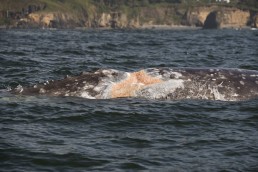Depoe Bay's Resident Gray Whales
Resident Gray Whales
Some gray whales do not continue to Alaskan waters but stay off the coast of Oregon between June and October. These part-time resident gray whales number about 200. About 60 whales are seen repeatedly off the central coast and have been photographed and identified. Of these, about 40 hang out between Lincoln City and Newport.
For whales to be known as residents, they must stay around a certain area for at least two days, exhibit feeding behavior, and return year after year. This distinguishes them from migrating whales which stop on their migration and feed then move on their way.
Along the coast of Depoe Bay, our resident gray whales begin showing up in June. Some arrive in early summer, leave, and then return in late summer or early fall. The resident whales leave in mid-October and return to the breeding lagoons of Baja California to rejoin the remainder of the population.
Resident gray whales remain around Depoe Bay for a period of days to months. These whales are also known as the Pacific Coast Feeding Group. Gray whales move about and feed off the Oregon coast during the summer and fall months. They are still migratory animals, but this group makes a shorter migration route if they find adequate food sources.
Scarback is the most famous resident gray whale here in Depoe Bay. Scarback can be identified by the large scar on her right dorsal hump. It is believed that she got her wound from an exploding harpoon which happened sometime between 1985 and 1988.
In the picture notice the orange coloration of the scar, this is whale lice, it is a crustacean that eats dead skin and is beneficial to the whale. Whale lice feed on the skin and damaged tissue helping the whales. The lice gather around open wounds or scars of the whale.
These lice can spread from mother whales to their calves during birth, and nursing. To get rid of the whale lice, whales rub themselves along the sea bottom or breach. Gray whales feed on bottom sediments such as amphipods and scrape off barnacles and whale lice as they feed.

